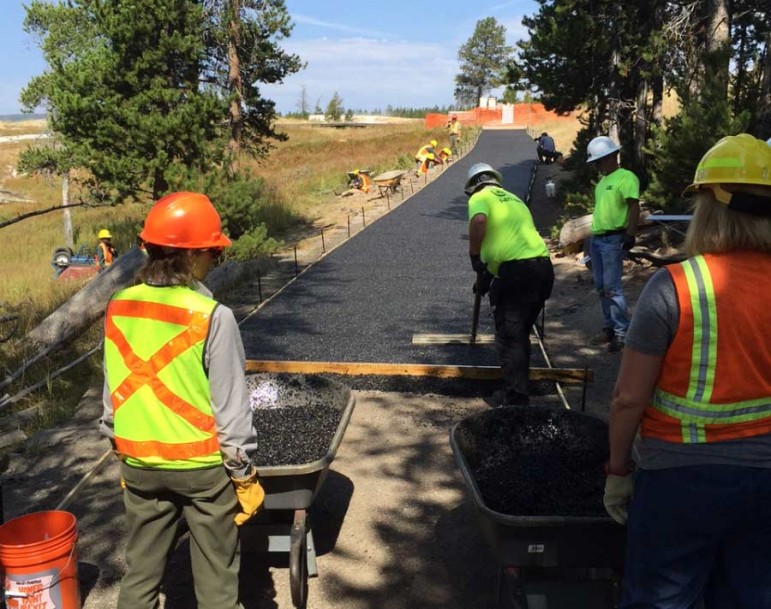
The best way to get the most out of a visit to Yellowstone National Park is to park the car and explore some of the many paths and trails that wind through a range of unique wonders. So it’s fitting that one of the newest paths in Yellowstone is built from recycled car tires.
Working with corporate sponsors, volunteers and park boosters, Yellowstone has rebuilt an existing pathway at Old Faithful with a paved surface that is porous, allowing rain and snow to percolate to the water table below. That helps maintain the groundwater system that recharges geysers and other thermal features in the area.
The project was made possible through a partnership between Yellowstone, park concessioners, corporate sponsors and the nonprofit Yellowstone Park Foundation, the official fundraising partner for the park.
The permeable paved surface, called FlexiPave, was developed by K.B. Industries, and uses recycled tires provided by Michelin, with both companies offering support for the project. Project managers said the repurposed tire rubber and other components create a stable material that does not leach oil—as asphalt can.
But besides the feel-good public relations that comes from supporting a project in Yellowstone, the new path addresses a serious issue that stems from the heavy development around Old Faithful. Impermeable asphalt used in numerous paths and parking lots is preventing precipitation from flowing naturally into hydrologic systems.
“We take the ecological integrity of Yellowstone very seriously,” said Steve Iobst, deputy superintendent of Yellowstone.
A science panel met in June 2013 to review best management practices for the Old Faithful area. One of the recommendations from the group’s report was to “avoid increasing the area of impermeable ground cover such as asphalt, concrete and buildings.”
The new path resurfaces a 6,400-square-foot stretch of existing asphalt that was in horrible disrepair, said Melinda Gable, spokeswoman for the Yellowstone Park Foundation.
The path is a heavily traveled route that lies between the Old Faithful Snow Lodge and a bridge that sits below and behind Old Faithful geyser, Gable said.
Workers used 900 worn out tires that had been previously donated to Yellowstone by Michelin for use on park vehicles several years ago.
Michelin is a major sponsor of the Yellowstone Park Foundation, and has donated tires to help equip Yellowstone’s fleet of more than 800 vehicles and equipment, which includes everything from passenger vehicles to electric carts, garbage trucks and even rotary snow plows.
Among the options discussed at the 2013 Old Faithful science conference were replacing existing paved areas with permeable surfaces, such as gravel, as well as shuttling visitors in from new off-site parking areas if the need for additional parking became unavoidable.
But significantly restricting access to the park’s most visited attraction is not a popular option. So park managers have worked since the conference to find new ideas for how to better manage the throngs by making small changes that cost relatively little.
More than a century of development around Old Faithful has left a legacy of structures built atop thermally active ground and a network of buried water, sewer and power lines that wasn’t always planned or mapped as carefully as it should have been.
Park officials say future development will be guided by the science panel’s findings, and follow a master plan that emphasizes caution in preserving Old Faithful’s complex hydrologic systems.
Contact Ruffin Prevost at 307-213-9818 or [email protected].
